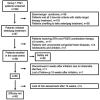Selexipag-based triple combination therapy improves prognosis in Chinese pulmonary arterial hypertension patients
- PMID: 36204579
- PMCID: PMC9530145
- DOI: 10.3389/fcvm.2022.991586
Selexipag-based triple combination therapy improves prognosis in Chinese pulmonary arterial hypertension patients
Abstract
Aim: Selexipag is an oral selective prostacyclin receptor agonist approved for treatment of patients with pulmonary arterial hypertension (PAH). In the present study, we aim to assess the safety and efficacy of selexipag in triple combination therapy with endothelial receptor antagonists (ERAs) and PDE5is for Chinese PAH patients.
Methods and results: A single center retrospective study was performed on group 1 PAH patients (n = 68) initiating triple combination therapy with selexipag from 1 February 2020 to 31 August 2021 in Qilu Hospital of Shandong University (Shandong, China). Adolescents, children, and PAH patients with unrepaired congenital heart disease were excluded. The French pulmonary hypertension network (FPHN) non-invasive risk assessment, echocardiogram parameters, and clinical data, including tolerability, safety, and death/hospitalization events associated with PAH, were collected. Of the 68 patients, 31 (45.6%) patients had tolerable side effects while only a single patient discontinued selexipag due to severe diarrhea. In the analysis of the efficacy set of 62 patients, the median selexipag treatment time from selexipag initiation to last risk assessment was 27 (21, 33) weeks. Compared to baseline parameters, the percentage of WHO FC III/IV decreased from 77.4% (48) to 24.2% (15) (p = 0.000), median 6-min walk distance (6MWD) increased 82 m [from 398 (318, 450) to 480 (420, 506) m; p = 0.000], and NT-proBNP levels decreased from 1,216 (329, 2,159) to 455 (134, 1,678) pg/mL (p = 0.007). Patients who improved to three low-risk criteria increased from 9.7 to 38.7%. Right ventricular diameter (RV) diameter also decreased and was accompanied by an improved tricuspid annular plane systolic excursion (TAPSE). Patients transitioning from subcutaneous treprostinil to selexipag continued to show improvements in WHO FC, 6MWD (404 ± 94 vs. 383 ± 127 m) and NT-proBNP levels (2,319 ± 2,448 vs. 2,987 ± 3,770 pg/mL). Finally, the 1-year event free survival rate was 96.7% for patients initiating the triple combination therapy within 3 years of PAH diagnosis.
Conclusion: Triple combination therapy with selexipag was safe and effective in Chinese PAH patients, which was confirmed by acceptable tolerability, and improved exercise capacity, right heart function, risk assessment, and prognosis.
Keywords: pulmonary arterial hypertension; risk assessment; selexipag; tolerability; triple combination.
Copyright © 2022 Cui, Lu, Zhang, Qie, Li, Li, Liu and Ji.
Conflict of interest statement
The authors declare that the research was conducted in the absence of any commercial or financial relationships that could be construed as a potential conflict of interest.
Figures




Similar articles
-
Impact of different sequential triple oral combination therapies based selexipag on outcomes in pulmonary arterial hypertension.Clin Cardiol. 2024 Feb;47(2):e24245. doi: 10.1002/clc.24245. Clin Cardiol. 2024. PMID: 38402556 Free PMC article.
-
Evaluating the efficacy and safety of oral triple sequential combination therapy for treating patients with pulmonary arterial hypertension: A multicenter retrospective study.Pulm Circ. 2024 Mar 10;14(1):e12351. doi: 10.1002/pul2.12351. eCollection 2024 Jan. Pulm Circ. 2024. PMID: 38468630 Free PMC article.
-
Real-Life Experience with Selexipag as an Add-On Therapy to Oral Combination Therapy in Patients with Pulmonary Arterial or Distal Chronic Thromboembolic Pulmonary Hypertension: A Retrospective Analysis.Lung. 2019 Jun;197(3):353-360. doi: 10.1007/s00408-019-00222-7. Epub 2019 Apr 8. Lung. 2019. PMID: 30963265
-
Prostacyclin for pulmonary arterial hypertension.Cochrane Database Syst Rev. 2019 May 1;5(5):CD012785. doi: 10.1002/14651858.CD012785.pub2. Cochrane Database Syst Rev. 2019. PMID: 31042010 Free PMC article.
-
A Special Focus on Selexipag - Treatment of Pulmonary Arterial Hypertension.Curr Pharm Des. 2017;23(34):5191-5199. doi: 10.2174/1381612823666170908114227. Curr Pharm Des. 2017. PMID: 28891448 Review.
Cited by
-
Impact of different sequential triple oral combination therapies based selexipag on outcomes in pulmonary arterial hypertension.Clin Cardiol. 2024 Feb;47(2):e24245. doi: 10.1002/clc.24245. Clin Cardiol. 2024. PMID: 38402556 Free PMC article.
-
Evaluating the efficacy and safety of oral triple sequential combination therapy for treating patients with pulmonary arterial hypertension: A multicenter retrospective study.Pulm Circ. 2024 Mar 10;14(1):e12351. doi: 10.1002/pul2.12351. eCollection 2024 Jan. Pulm Circ. 2024. PMID: 38468630 Free PMC article.
-
Oral Prostacyclin Pathway Agents Used in PAH: A Targeted Literature Review.Clinicoecon Outcomes Res. 2024 May 30;16:447-459. doi: 10.2147/CEOR.S460912. eCollection 2024. Clinicoecon Outcomes Res. 2024. PMID: 38831921 Free PMC article. Review.
-
Prognostic Value of Serial Risk Stratification in Adult and Pediatric Pulmonary Arterial Hypertension: A Systematic Review.J Am Heart Assoc. 2024 Jul 2;13(13):e034151. doi: 10.1161/JAHA.123.034151. Epub 2024 Jun 21. J Am Heart Assoc. 2024. PMID: 38904230 Free PMC article.
References
-
- Simonneau G, Barst RJ, Galie N, Naeije R, Rich S, Bourge RC, et al. Continuous subcutaneous infusion of treprostinil, a prostacyclin analogue, in patients with pulmonary arterial hypertension: a double-blind, randomized, placebo-controlled trial. Am J Respir Crit Care Med. (2002) 165:800–4. 10.1164/ajrccm.165.6.2106079 - DOI - PubMed
-
- Hoeper MM, McLaughlin VV, Barbera JA, Frost AE, Ghofrani HA, Peacock AJ, et al. Initial combination therapy with ambrisentan and tadalafil and mortality in patients with pulmonary arterial hypertension: a secondary analysis of the results from the randomised, controlled AMBITION study. Lancet Respir Med. (2016) 4:894–901. 10.1016/S2213-2600(16)30307-1 - DOI - PubMed
LinkOut - more resources
Full Text Sources
Research Materials

